(This is the second of a two-part series)
I had collected baseball cards as a youngster in the fifties. Unfortunately, I gave my collection to a good friend in 1957 when my family moved from the small town of Lunenburg in Nova Scotia to the city of Edmonton, Alberta. At that point, my life was over – or so I thought, and I wanted my best friend to have my cards. Even more unfortunately, they were lost in a fire that later badly damaged my friend’s home.
As a teenager in Edmonton I didn’t acquire any cards. In fact, I don’t recall seeing them in the stores of the city. In any event, I expect my money was more important for other things at that point.
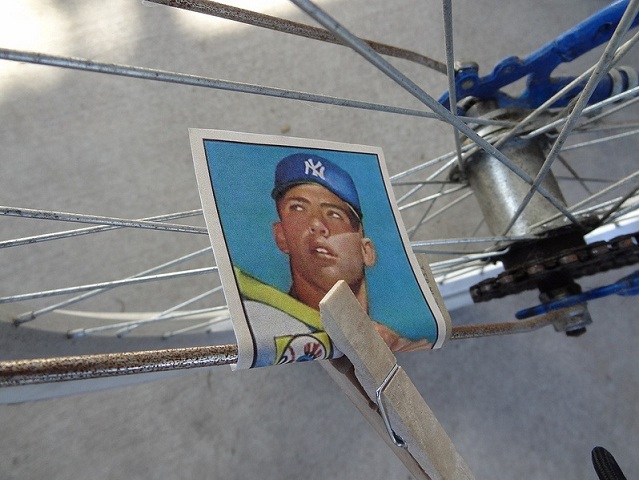
Yes, that’s a 1952 Mickey Mantle card clothes-pinned to the tire of that bicycle. Oh, if we had only known. (Photo credit – Jim Degerstrom)
After a hiatus of twenty-eight years, I began collecting cards again in 1985. I purchased a 1981 boxed Fleer set from a card shop in Los Angeles. For the next ten years our son Jamie and myself went on a bit of a collecting binge (but I can stop at any time, mind you). During that time I easily acquired about 30,000 cards, mostly in boxed sets at very reasonable costs. Jamie also purchased many cards, probably in the 20,000 range.
At the same time, we collected individual cards – mostly of players that were playing with star quality and players we tried to predict would become stars. Hence, with Ben MacDonald, Andy Benes, Alex Fernandez cards, I proved that even then success was difficult to predict. I did, however, collect quite a few Tony Gwynn cards and Jamie quite a few Kirby Puckett cards during this span, but most of my focus was on collecting Dodger cards.
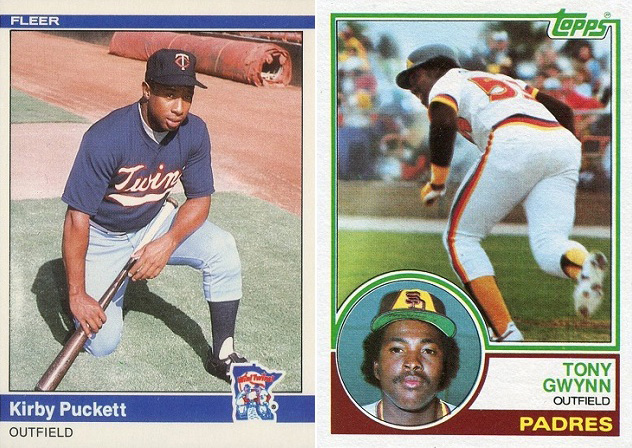
Jamie and I were elated when both Kirby Puckett and Tony Gwynn were inducted into the Hall of Fame in 2001 and 2007 respectively. Having bought many of their cards over the years, it almost felt as though we had helped them make it there.
After about ten years in hot pursuit of cards of our choice, things changed. There now seemed to be an indefinite number of companies producing cards – Topps, Bowman, Fleer, Donruss, Score, Sportflics, Leaf, O-Pee-Chee, Upper Deck, Studio, and it became difficult to acquire all of those sets.
To complicate matters, it became difficult to even find boxed sets after 1995. Cards shows in our area had disappeared, card shops closed up, eBay was just getting off the ground and was not yet an option for buying cards, and entirely new marketing schemes took over. Card companies began releasing two or three completely different series every year and made them available only in packs of ten (or so) for $2.95 or more per pack. Each series contained special cards that were almost impossible to acquire in order to complete that set. Their goal, of course, was to get you to buy more packs of cards in your effort to get those elusive special cards and you ended up with a lot of doubles or triples that you did not need – and you were still missing that special card; a scheme if ever there were one… and a scam.
The cost of collecting a set of cards in that manner and the frustration of so many companies producing cards caused us to change our collecting habits. We began collecting only individual cards when we could find them and I continued to pursue Dodger cards. We thought that our concerns were peculiar to us because of where we lived (in rural Nova Scotia). Little did we know that the path that we were forced into was a path that was being followed by thousands of card collectors around the world.
How did this all come about? A number of things happened. After World War II Topps was the only company still producing cards. Topps enjoyed decades with no real rivals, until a legal decision at the beginning of the 1980’s opened the doors for other would be manufacturers to enter the fray. Fleer, Donruss and other companies started production thinking a baseball card boom was in the making. At the height of their popularity in the early 1990’s, card manufacturers produced an estimated 81 billion baseball cards a year. “That’s about 325 cards for every man, woman, and child in the United States,” notes Dave Jamieson in his book, “Mint Condition: How Baseball Cards Became an American Obsession”
The boom turned out to be a bust as card companies were bought out or went bankrupt. Last year, Major League Baseball decided they were only going to renew their contract with Topps, so we are back where we started with Topps a sole distributor of baseball cards. Well, not quite, as Panini and Upper Deck have an arrangement with the Major League Baseball Players Association giving them the right to make MLBPA-approved baseball cards, but without team logos or nicknames on their products. Who would want baseball cards without “Dodgers” or “LA” or the Dodger logo on display?
What caused the glut on the market that killed the industry as an investment industry as some had envisioned? A court decision, yes, but there were other factors. In 1979, James Beckett published the first comprehensive book of its kind entitled Beckett Baseball Card Price Guide (which now comes out annually and even has a monthly on-line subscription) that put a published price on individual cards, thus changing how people, young and old, looked at cards. This publication may have had an influence on the belief that baseball cards could be an investment opportunity such as precious metals and, as such, should be produced in large volume.
As Dave Jamieson wrote in Mint Condition – “It was greed on the part of card makers because they rolled out so much product that it diluted the power of the cards and killed the golden goose. It was greed on the part of the baseball union, because they sold a lot of rights – and made a lot of royalties on those rights – until they had too many card makers. Then you had greed on the part of dealers, surly guys who didn’t care to talk to the nine-year-olds who came into their shops, and were there just to sell cards. Finally, collectors were swallowing up everything thinking it was going to turn to gold.”
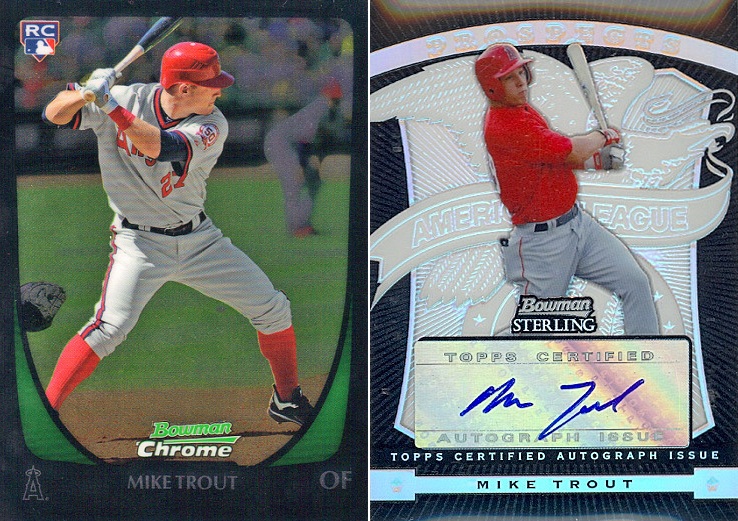
There are so many different Bowman Chrome series cards available each year that it boggles the mind. But what really boggles the mind is that the Bowman Mike Trout rookie card on the left sells for $10 and the one on the right sells for $10,000.
Another suspect in the fall of the baseball card was the baseball strike of 1994-95. The strike opened the door for other sports to fill the void in interest and in purchasing cards. Young collectors turned to Pokemon and Yu-Gi-Ho cards in droves. For me the reason for the decline is that card collecting no longer was a hobby. It had priced itself right out of the range of the very clientele that had supported it’s growth for more than a century – kids. The newer cards became more and more fancy, more glossy and, of course, more expensive – especially autographed cards.
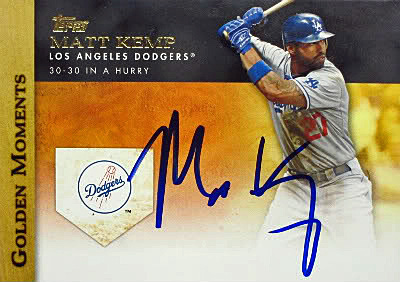
Although it’s always exciting (and expensive) to purchase autographed baseball cards, nothing beats the thrill of getting them personally autographed yourself, as ThinkBlueLA’s Ron Cervenka did with this Matt Kemp card at spring training last year.
Can the golden days of baseball card collecting be recovered? Probably not; but Dave Jamieson has the best idea yet: “…restore it to what it once was. They should convince everyone, children and adults alike, that baseball cards are exactly what they were before the boom times of the 1980’s and ‘90’s – cheap play things suitable for tacking to the wall, flicking on the playground, or stuffing into a shoe box.”




 December 17th, 2012 at 12:11 am
December 17th, 2012 at 12:11 am  by Harold Uhlman
by Harold Uhlman 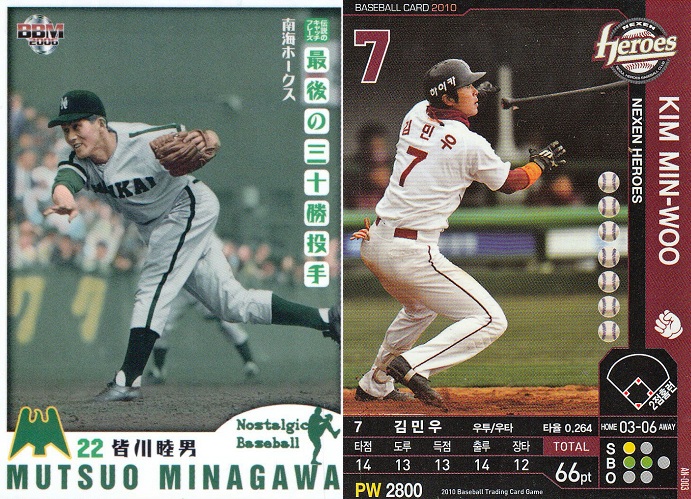
 Posted in
Posted in 

Mickey Mantle on the spokes of a bicycle.Now that is a felony. Topps first started to distribute baseball cards in Canada in 1952. As I remember it the first cards in our area were in 1954. Hockey cards were available for a few years before that, the first ones I remember being a small card.
There were no Mickey Mantle cards by Topps in 1954 and 1955 as Bowman had the rights to his cards for those two years. That explains why the Yankee fans couldn’t get a Mantle card while I could show off a Duke card. I liked to tell them Mickey wasn’t good enough to have his card produced. There was no checklist to indicate whose cards were released. Mickey’s true rookie card was a 1951 Bowman. Topps bought out Bowman in 1956.
I have that Gywnn rookie card as well as his O-Pee-Chee one, identical to the Topps card, released in Canada.
Another great read, Harold. I think I had as much fun digging up the graphics for your two-parter as you did writing it – then again, you gave me a great deal to work with, too. You also gave me an opportunity to show off one of my own personal favorite cards.
I can’t even begin to tell you how many “my mom threw out my cards” stories I’ve heard in my lifetime. In my case, it was my 100% complete 1968 Topps series – the one and only year that I acquired every single card in the entire set – and I did it buying one pack at a time (I had stacks of gum up to the ceiling).
Although my number one passion within my passion is getting baseballs autographed, your passion within your passion has rubbed off on me (but I can quit any time, mind you). Because of you, I now have roughly 200 cards (not to mention three binders full that Linda and Jim V generously gave to me). My prize collections are my Topps Don Drysdale and Sandy Koufax cards from every year that they actually played (including their rookie cards) – these and the Duke cards that you generously gave me.
I never had any doubt that you had that Gwynn rookie card or that Jamie had that Puckett rookie card (which, of course, is why I used them). And I actually cringed when I stumbled onto that 52 Mantle card in the bicycle spokes photograph. I seriously hope that it was a staged photograph using a photocopy of the card and not the actual card.
Anyway, thanks again for another great read.
Great graphics Ron. Really like Mickey – oh my – Mantle.
I had read about the Japanese card market, and the Canadian, but the article was a bit long as is.
I am going to get a copy of Dave Jamieson’s book. From reviews, it is considered to be the Bible re: history of baseball cards. As you have probably read, it all started when he discovered his card collection was basically worthless, in terms on dollars.
Some of the cards should have Garrett as a photographer. I’m sure if they tried they could get some even more unattractive poses. You know, with pitcher’s faces screwed up.
We both have last season’s Quakes team sets, which Garrett Nichols has mentioned that he took the photos for several of them. (It’s kind of cool knowing the guy who did that, huh?).
My favorite “faces screwed up” photos are those of Hiroki Kuroda – haha!
After reading your articles, I seriously considered getting Jamieson’s book, but then I would probably go hog-wild into card collecting. Good thing I can quit at any time, huh?
You can quit any time you want – autographed baseballs, donuts, eh!!
Good read, Harold. Who knows? Maybe one day I’ll find myself catching the bug and collecting cards as well. Thanks for sharing your passion with us.
Harold, Part 2 is just as good as Part 1.
My son and I did basically the same thing you and Jamie did. We started collecting around 1990 with getting the complete Topps set every year. Then we got seduced by the new companies and all their fancy new sets. Then it became overwhelming and we couldn’t keep up. That’s when we started to narrow down what we would collect. We stopped buying complete sets and then my son lost interest in it altogether. I continued for a while by buying just Dodger cards from the Topps regular issue set each year. I stopped and restarted collecting a couple of times over the past few years. Right now I’m in the stopped position.
Will- it seems thousands did the same thing. That is, give up when overwhelmed by the massive influx of cards. Hence the bust. Jamie also never went back to collecting. Of course post secondary education came along but he never started again after that.
If it was not for online buying I would be completely shut down with no local sources from which to purchase. Lots of hockey cards around.
Baseball cards will always be produced because collectors remain but investment opportunities don’t. It is pretty much just a retail business now with collectors buying to keep or trade.
I collected cards through high school. I traded them, flipped them, played “closest to the wall”, and even attached them to my bike (always a Giant!) for the motorcycle effect. When I came home from college for the first time in October, 1960, my mother informed me that:
1) She had put down my dog,
2) Thrown out my TV Guide collection (every issue from March, 1953 to July, 1960), and
3) Given all my cards to her friend’s son.
To say I was devastated would be the understatement of that or any year. I couldn’t get Penny or the TV Guides back, but at least there was hope for the cards. So my Mom called her friend and told her she hadn’t realized I wanted them and would like them back, only to be told, “Oh, Benjy didn’t want them so I put them in the garbage”.
When my son was 6 I bought him the entire Topps 1979 set from Renatta What’s-her-name and then did it again the next year, but he never got to experience the thrill of opening a pack and finding that elusive card that you needed to complete a series, and quickly lost interest. He does have two mint condition sets that may provide college educations for his sons some day assuming his wife doesn’t decide to pitch them. And I have my memories which, truly, are enough for me.